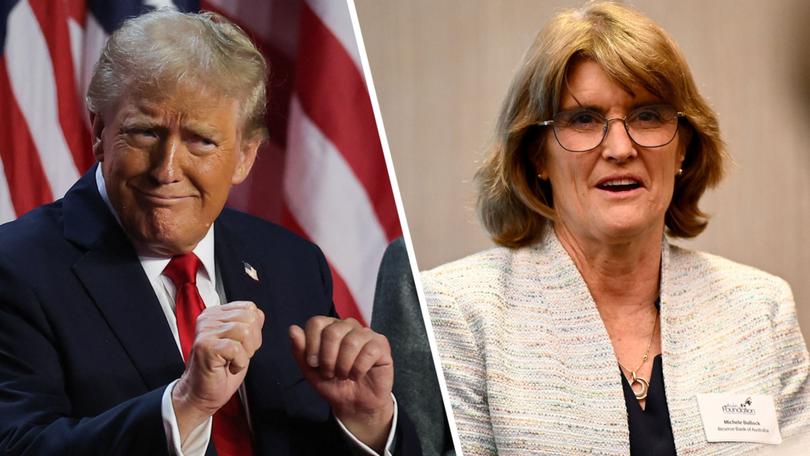Why the Reserve Bank is trapped between a Trump and hard place

One hundred and thirty thousand. That’s the staggering number of people who have been kept in work while the economy sits and stagnates.
As the US powers out of a downturn with a second consecutive rate cut overnight Friday, our Reserve Bank is stuck on the sidelines wondering what is going to happen to the global economy when a 100-tonne Trump truck crashes onto the track.
The RBA made a call back in 2022 that protecting jobs was as important as tackling inflation.
Sign up to The Nightly's newsletters.
Get the first look at the digital newspaper, curated daily stories and breaking headlines delivered to your inbox.
By continuing you agree to our Terms and Privacy Policy.When other central banks started hiking rates in February 2022, the RBA waited until May.
Other central banks went harder: The Federal Reserve lifted rates to 5.35 per cent, the Bank of England to 5.25 and New Zealand’s to 5.5. We stayed at 4.35 per cent, where it has been for the past year.
That saved the jobs of 130,000 people according to Treasury Secretary Steven Kennedy. Treasury, and the RBA, calculate that if unemployment rose to 5.5 per cent, as it did in New Zealand, that’s the number of people who would be out of work.
Treasurer Jim Chalmers should be rapt. Instead he’s staring at a no-growth economy headed into an election year.
Independent economist Saul Eslake says Mr Chalmers was “very silly” to say the Reserve Bank had smashed the economy.
“He could instead be saying, ‘Yes, interest rates have followed a different trajectory from other countries, but this would be the first time that we have dealt with unacceptably high inflation without causing job losses’.
“I would have thought that’s a good story to tell,” Mr Eslake says.
Robbing Schumpeter to pay Paul
We’ve kept people in work but the problem for Australia now, as rates fall among all our peers, is that the RBA and the Government have sacrificed future dynamism for short-term gain.
“They’ve got the arithmetic wrong in their mind, saying we don’t want people to lose their jobs,” says Christian Baylis, founder and chief investment officer of Fortlake Asset Management and a former RBA economist.
“You’ve got 130,000 people which you’ve effectively gone and tried to save, and you’ve basically said to the rest of the country — the other 27 odd million people — that we’re going to make you pay higher prices for another year-and-a-half, two years longer for that. To me, that’s just a really stupid trade off.”
The German economist Joseph Schumpeter coined the term “creative destruction”. It is the necessary destruction of old, uneconomic structures to create new growth. It is the source of productivity, the magic elixir for economic growth.
Our productivity is in the scheiss haus. It has fallen to 0.9 per cent, down a quarter from the previous year.
America just reported that productivity is soaring — up 2.2 annually.
Why? Because of the way the different governments handled the COVID-19 crisis.
The US was the only Western country to not have a job preservation scheme during COVID. They gave money to consumers. Australia propped up employers.
“One consequence was that people were locked into jobs for longer than they might otherwise,” Mr Eslake says. “We’ve got a lot of people doing jobs that they’re perhaps not best suited for, whereas the US had a kind of forced reallocation of labour, and one of the sources of productivity growth is people moving to jobs where they can be more productive.”
The other problem is that too many businesses are chugging along in zombie mode. Despite a few impairments and insolvencies in the bank reports this week business exit rates are at record lows.
Mr Eslake blames “small business fetishism” for that, partly.
“The belief that there’s something inherently more noble about running a small business than working for a big one has given us policies like the lower rate of company tax for businesses with small turnover or high payroll tax threshold exemption thresholds, that is crap,” he says.
“Small business has inherently lower productivity than bigger businesses, it’s not the engine room of the economy and, in aggregate, hasn’t created a single job in the last 15 years.”
Not biting the bullet on rates has kept the economy clogged.
“How do you fix productivity? The cruel way of doing it is you push cash rates up really high, and you see who’s survival of the fittest, because that will have a cleansing effect on the least productive businesses in the economy,” Mr Baylis says.
“It’s a cruel and harsher way of getting productivity higher, but nevertheless, it does make you more productive, I think the RBA has made a few mistakes with the way that they’ve sort of perceived those trade offs.”
Waiting game
Talk to bank CEOs and the impression is the worst is over. ANZ’s Shayne Elliott suggested that borrowers in arrears peaked in June and has stayed flat since. NAB has seen similar numbers.
Mr Elliott reckons that might just be a factor of tax cuts coming through, which if the case is hardly cause for jubilation. Customers appear to be sitting pat hoarding cash in their offset buffers and scrimping and saving elsewhere.
A rate cut would get things moving again but Mr Elliott wasn’t confident that would happen anytime soon. Speaking to reporters on Friday, he pushed back his estimate for a rate cut until after the halfway mark of next year.
What happens next comes down to the dollar and the RBA will have to wait and see where it lands. If the dollar falls too far as part of Trump’s turbocharge then the danger is Australia imports inflation and has to keep rates elevated.
Trump takes office in January, and while he is a man of action, it will take time for his policies to flow through.
The RBA won’t want to move too soon and have to course correct, which is why it’s stuck in neutral.

